Page 83 of 531
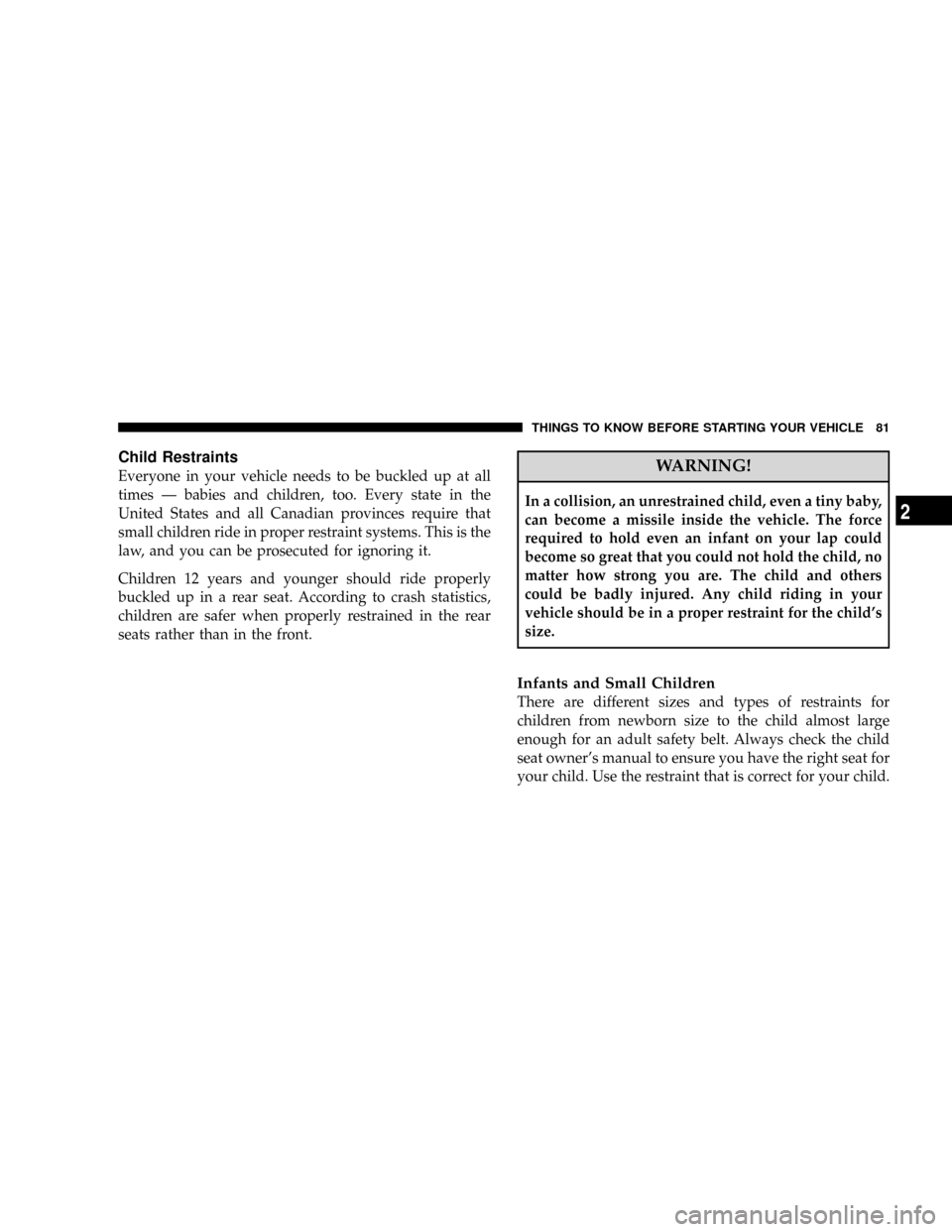
Child Restraints
Everyone in your vehicle needs to be buckled up at all
times Ð babies and children, too. Every state in the
United States and all Canadian provinces require that
small children ride in proper restraint systems. This is the
law, and you can be prosecuted for ignoring it.
Children 12 years and younger should ride properly
buckled up in a rear seat. According to crash statistics,
children are safer when properly restrained in the rear
seats rather than in the front.WARNING!
In a collision, an unrestrained child, even a tiny baby,
can become a missile inside the vehicle. The force
required to hold even an infant on your lap could
become so great that you could not hold the child, no
matter how strong you are. The child and others
could be badly injured. Any child riding in your
vehicle should be in a proper restraint for the child's
size.
Infants and Small Children
There are different sizes and types of restraints for
children from newborn size to the child almost large
enough for an adult safety belt. Always check the child
seat owner's manual to ensure you have the right seat for
your child. Use the restraint that is correct for your child.
THINGS TO KNOW BEFORE STARTING YOUR VEHICLE 81
2
Page 84 of 531
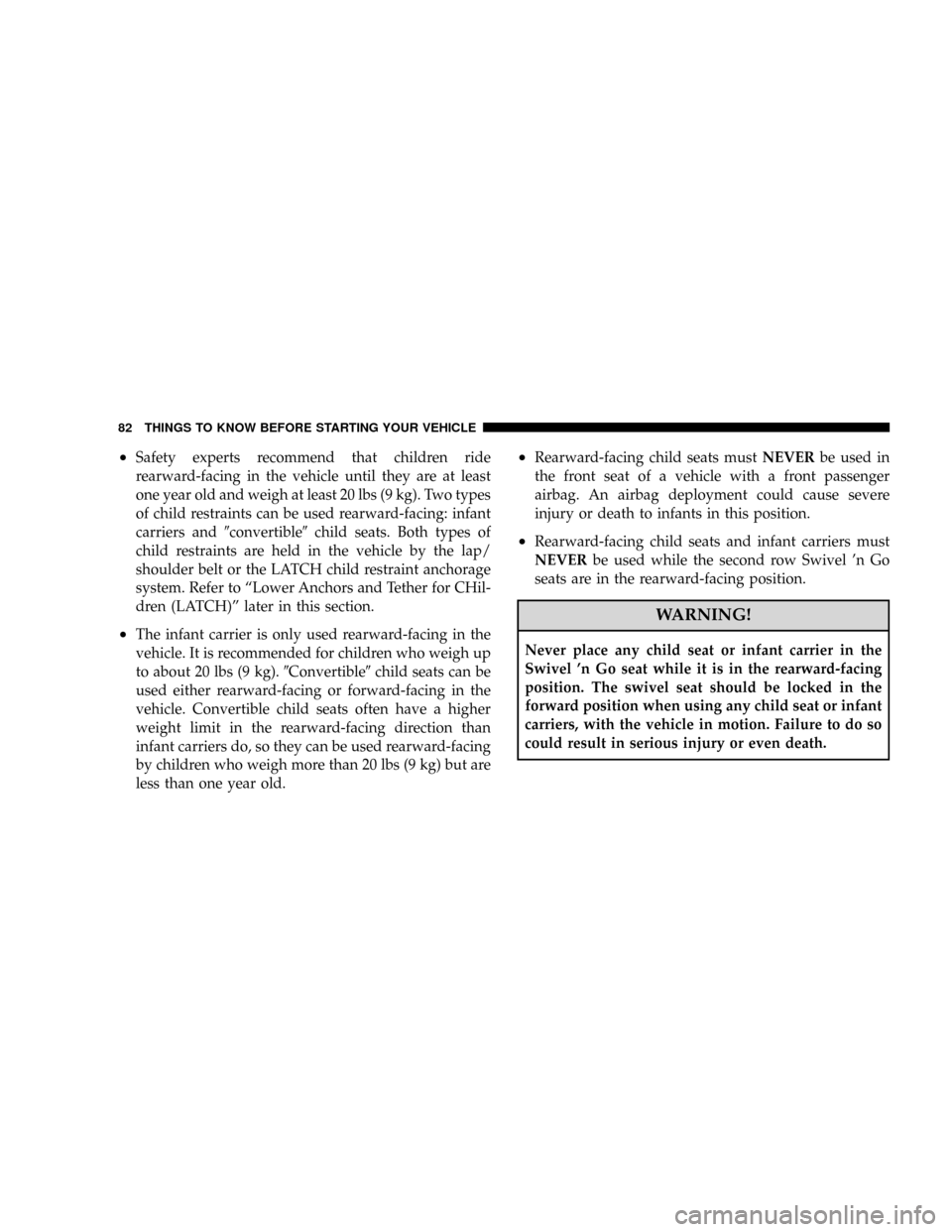
²Safety experts recommend that children ride
rearward-facing in the vehicle until they are at least
one year old and weigh at least 20 lbs (9 kg). Two types
of child restraints can be used rearward-facing: infant
carriers and9convertible9child seats. Both types of
child restraints are held in the vehicle by the lap/
shoulder belt or the LATCH child restraint anchorage
system. Refer to ªLower Anchors and Tether for CHil-
dren (LATCH)º later in this section.
²The infant carrier is only used rearward-facing in the
vehicle. It is recommended for children who weigh up
to about 20 lbs (9 kg).9Convertible9child seats can be
used either rearward-facing or forward-facing in the
vehicle. Convertible child seats often have a higher
weight limit in the rearward-facing direction than
infant carriers do, so they can be used rearward-facing
by children who weigh more than 20 lbs (9 kg) but are
less than one year old.
²Rearward-facing child seats mustNEVERbe used in
the front seat of a vehicle with a front passenger
airbag. An airbag deployment could cause severe
injury or death to infants in this position.
²Rearward-facing child seats and infant carriers must
NEVERbe used while the second row Swivel 'n Go
seats are in the rearward-facing position.
WARNING!
Never place any child seat or infant carrier in the
Swivel 'n Go seat while it is in the rearward-facing
position. The swivel seat should be locked in the
forward position when using any child seat or infant
carriers, with the vehicle in motion. Failure to do so
could result in serious injury or even death.
82 THINGS TO KNOW BEFORE STARTING YOUR VEHICLE
Page 85 of 531
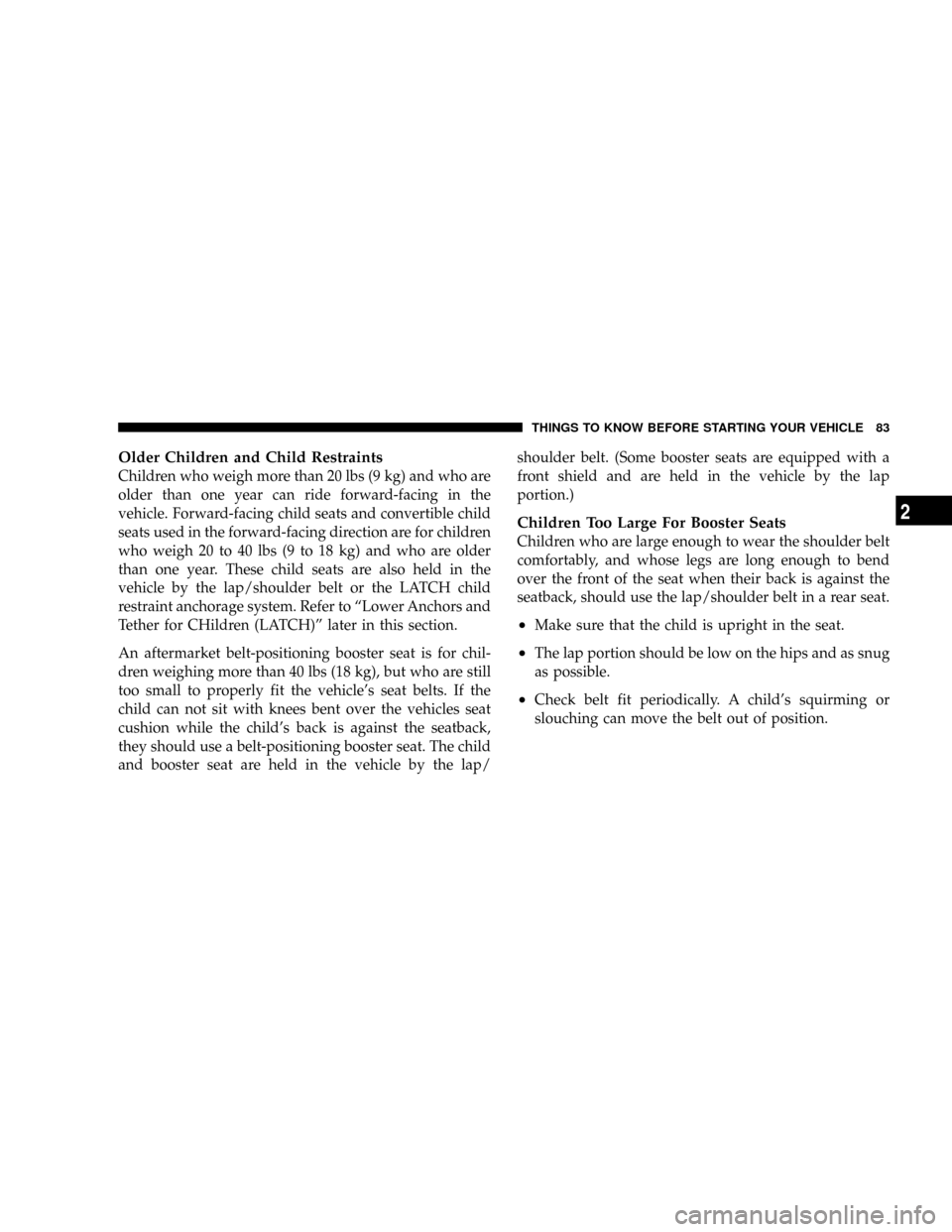
Older Children and Child Restraints
Children who weigh more than 20 lbs (9 kg) and who are
older than one year can ride forward-facing in the
vehicle. Forward-facing child seats and convertible child
seats used in the forward-facing direction are for children
who weigh 20 to 40 lbs (9 to 18 kg) and who are older
than one year. These child seats are also held in the
vehicle by the lap/shoulder belt or the LATCH child
restraint anchorage system. Refer to ªLower Anchors and
Tether for CHildren (LATCH)º later in this section.
An aftermarket belt-positioning booster seat is for chil-
dren weighing more than 40 lbs (18 kg), but who are still
too small to properly fit the vehicle's seat belts. If the
child can not sit with knees bent over the vehicles seat
cushion while the child's back is against the seatback,
they should use a belt-positioning booster seat. The child
and booster seat are held in the vehicle by the lap/shoulder belt. (Some booster seats are equipped with a
front shield and are held in the vehicle by the lap
portion.)
Children Too Large For Booster Seats
Children who are large enough to wear the shoulder belt
comfortably, and whose legs are long enough to bend
over the front of the seat when their back is against the
seatback, should use the lap/shoulder belt in a rear seat.
²Make sure that the child is upright in the seat.
²The lap portion should be low on the hips and as snug
as possible.
²Check belt fit periodically. A child's squirming or
slouching can move the belt out of position.
THINGS TO KNOW BEFORE STARTING YOUR VEHICLE 83
2
Page 88 of 531
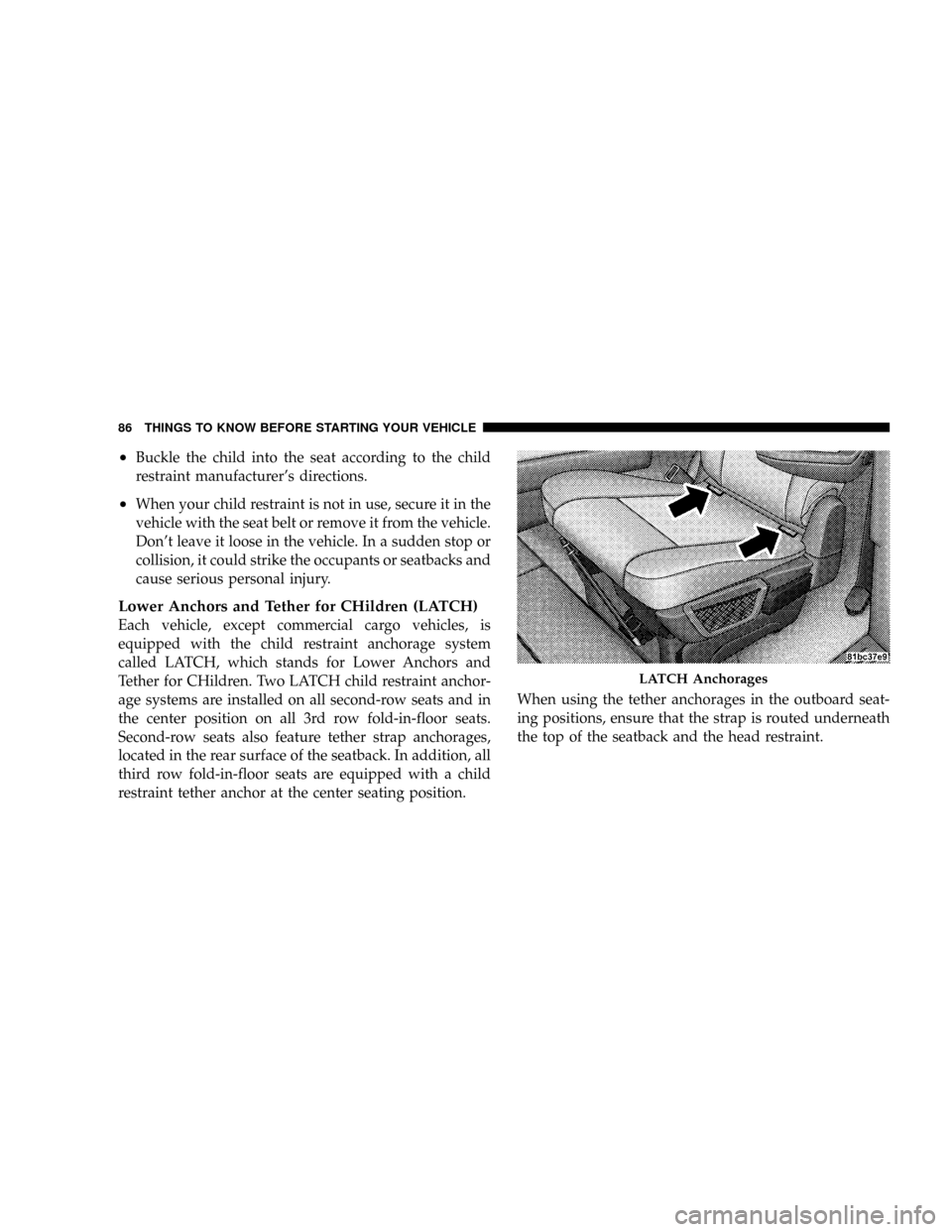
²Buckle the child into the seat according to the child
restraint manufacturer's directions.
²When your child restraint is not in use, secure it in the
vehicle with the seat belt or remove it from the vehicle.
Don't leave it loose in the vehicle. In a sudden stop or
collision, it could strike the occupants or seatbacks and
cause serious personal injury.
Lower Anchors and Tether for CHildren (LATCH)
Each vehicle, except commercial cargo vehicles, is
equipped with the child restraint anchorage system
called LATCH, which stands for Lower Anchors and
Tether for CHildren. Two LATCH child restraint anchor-
age systems are installed on all second-row seats and in
the center position on all 3rd row fold-in-floor seats.
Second-row seats also feature tether strap anchorages,
located in the rear surface of the seatback. In addition, all
third row fold-in-floor seats are equipped with a child
restraint tether anchor at the center seating position.When using the tether anchorages in the outboard seat-
ing positions, ensure that the strap is routed underneath
the top of the seatback and the head restraint.
LATCH Anchorages
86 THINGS TO KNOW BEFORE STARTING YOUR VEHICLE
Page 91 of 531
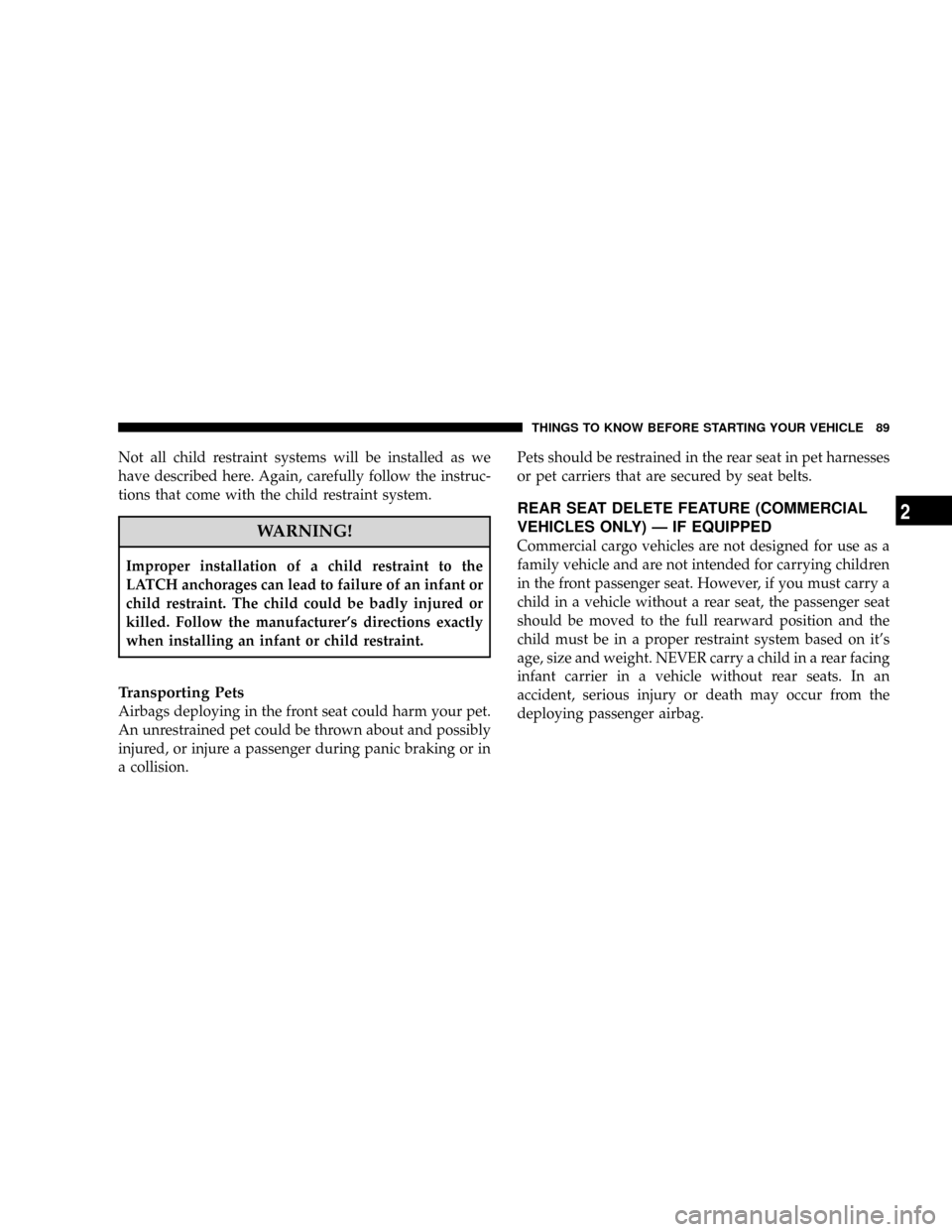
Not all child restraint systems will be installed as we
have described here. Again, carefully follow the instruc-
tions that come with the child restraint system.
WARNING!
Improper installation of a child restraint to the
LATCH anchorages can lead to failure of an infant or
child restraint. The child could be badly injured or
killed. Follow the manufacturer's directions exactly
when installing an infant or child restraint.
Transporting Pets
Airbags deploying in the front seat could harm your pet.
An unrestrained pet could be thrown about and possibly
injured, or injure a passenger during panic braking or in
a collision.Pets should be restrained in the rear seat in pet harnesses
or pet carriers that are secured by seat belts.
REAR SEAT DELETE FEATURE (COMMERCIAL
VEHICLES ONLY) Ð IF EQUIPPED
Commercial cargo vehicles are not designed for use as a
family vehicle and are not intended for carrying children
in the front passenger seat. However, if you must carry a
child in a vehicle without a rear seat, the passenger seat
should be moved to the full rearward position and the
child must be in a proper restraint system based on it's
age, size and weight. NEVER carry a child in a rear facing
infant carrier in a vehicle without rear seats. In an
accident, serious injury or death may occur from the
deploying passenger airbag.
THINGS TO KNOW BEFORE STARTING YOUR VEHICLE 89
2
Page 93 of 531
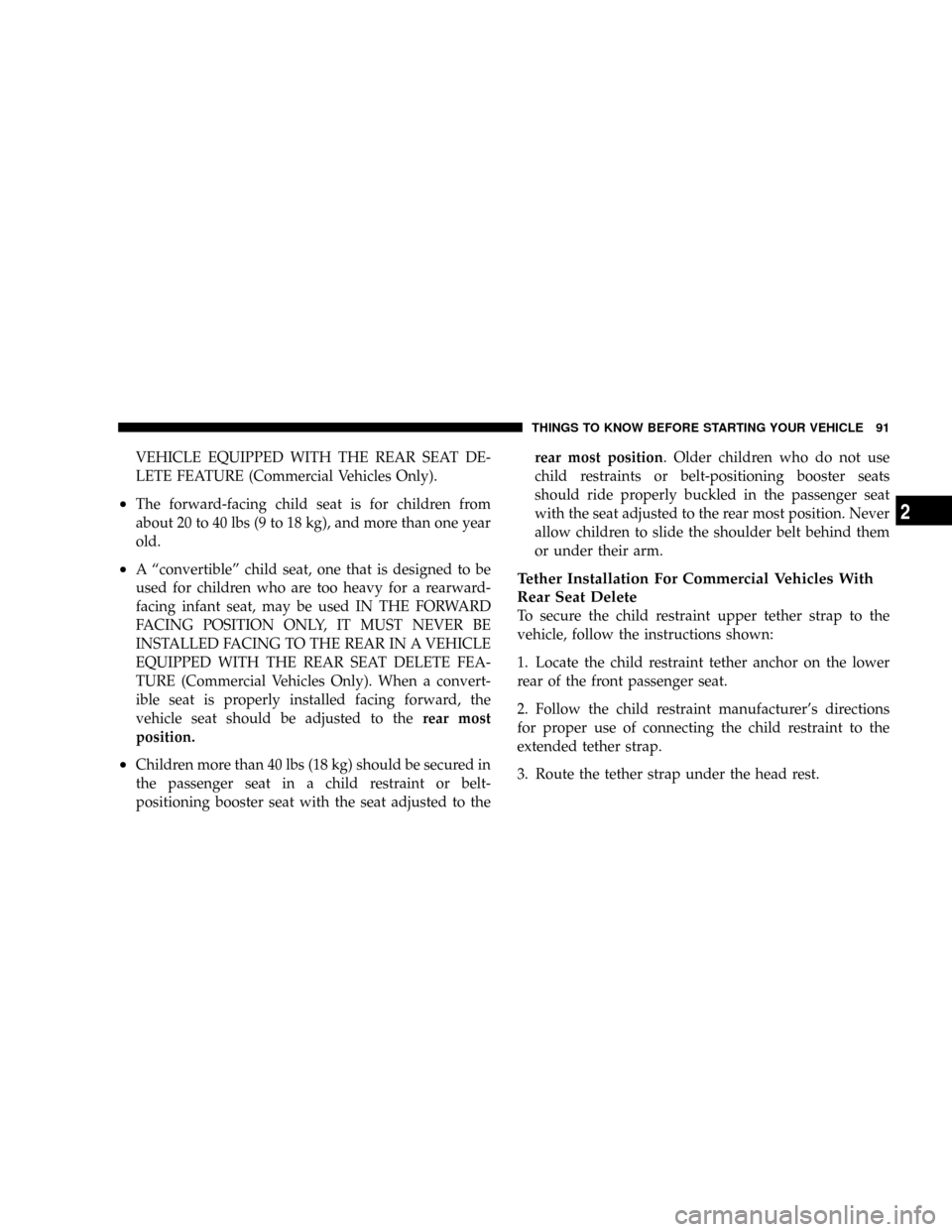
VEHICLE EQUIPPED WITH THE REAR SEAT DE-
LETE FEATURE (Commercial Vehicles Only).
²The forward-facing child seat is for children from
about 20 to 40 lbs (9 to 18 kg), and more than one year
old.
²A ªconvertibleº child seat, one that is designed to be
used for children who are too heavy for a rearward-
facing infant seat, may be used IN THE FORWARD
FACING POSITION ONLY, IT MUST NEVER BE
INSTALLED FACING TO THE REAR IN A VEHICLE
EQUIPPED WITH THE REAR SEAT DELETE FEA-
TURE (Commercial Vehicles Only). When a convert-
ible seat is properly installed facing forward, the
vehicle seat should be adjusted to therear most
position.
²Children more than 40 lbs (18 kg) should be secured in
the passenger seat in a child restraint or belt-
positioning booster seat with the seat adjusted to therear most position. Older children who do not use
child restraints or belt-positioning booster seats
should ride properly buckled in the passenger seat
with the seat adjusted to the rear most position. Never
allow children to slide the shoulder belt behind them
or under their arm.
Tether Installation For Commercial Vehicles With
Rear Seat Delete
To secure the child restraint upper tether strap to the
vehicle, follow the instructions shown:
1. Locate the child restraint tether anchor on the lower
rear of the front passenger seat.
2. Follow the child restraint manufacturer's directions
for proper use of connecting the child restraint to the
extended tether strap.
3. Route the tether strap under the head rest.
THINGS TO KNOW BEFORE STARTING YOUR VEHICLE 91
2
Page 99 of 531
UNDERSTANDING THE FEATURES OF YOUR VEHICLE
CONTENTS
mMirrors..............................100
NManual Rear View Day/Night Mirror Ð
If Equipped.........................100
NExterior Mirrors......................102
mHands-Free Communication (UConnectt)Ð
If Equipped...........................104
NOperation...........................106
NPhone Call Features...................113
NUConnecttSystem Features..............116
NAdvanced Phone Connectivity............120NThings You Should Know About Your
UConnecttSystem....................122
NGeneral Information...................131
mSeats................................131
NManual Front And Second Row Seat
Adjuster............................132
NStow 'n Go Seating Ð If Equipped.........138
NSwivel 'n Go Premium Seating Ð
If Equipped.........................148
mDriver Memory Seat Ð If Equipped.........155
3
Page 133 of 531
General Information
This device complies with Part 15 of the FCC rules and
RSS 210 of Industry Canada. Operation is subject to the
following conditions:
²This device may not cause harmful interference.
²This device must accept any interference received,
including interference that may cause undesired op-
eration.
SEATS
Seats are a primary part of the Occupant Restraint
(protection) System of the vehicle. They need to be used
properly for safe operation of the vehicle.
WARNING!
²DO NOT allow people to ride in any area of your
vehicle that is not equipped with seats and seat
belts. In a collision, people riding in these areas
are more likely to be seriously injured or killed.
²Be sure everyone in your vehicle is in a seat and
using a seat belt properly.
UNDERSTANDING THE FEATURES OF YOUR VEHICLE 131
3